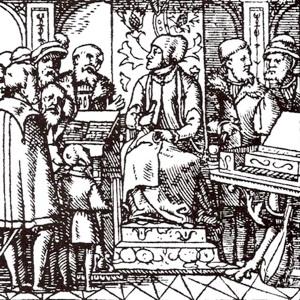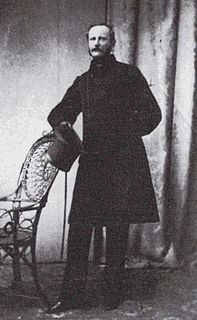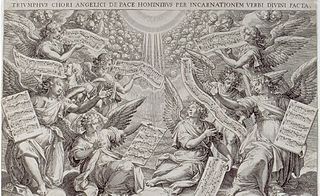
The cornet is a brass instrument similar to the trumpet but distinguished from it by its conical bore, more compact shape, and mellower tone quality. The most common cornet is a transposing instrument in B♭, though there is also a soprano cornet in E♭ and a cornet in C. All are unrelated to the renaissance and early baroque cornett.
The music of Belgium is a cultural crossroad where Flemish Dutch-speaking and Walloon French-speaking traditions mix with those of German minorities and of immigrant communities from Democratic Republic of the Congo and other distant countries.

Thomas Crecquillon or Créquillon was a Franco-Flemish school composer of the Renaissance. While his place of birth is unknown, it was probably within the region loosely known at the time as the Low Countries, and he probably died at Béthune.

TielmanSusato was a Renaissance composer, instrumentalist and publisher of music in Antwerp.

Steven Severin, is an English musician, composer, bassist, producer and co-founding member of Siouxsie and the Banshees. He took the name "Severin" from the Leopold von Sacher-Masoch character who is mentioned in the Velvet Underground song "Venus in Furs". Severin had earlier considered "Steve Spunker" for his stage name. After the split of Siouxsie and the Banshees in 1996, Severin created his own label RE, and released several instrumental albums via his official website. In the late 2000s and the early 2010s, he regularly performed live in solo, playing music over footage of silent films.

Joseph Jean-Baptiste Laurent Arban was a cornetist, conductor, composer, pedagogue and the first famed virtuoso of the cornet à piston or valved cornet. He was influenced by Niccolò Paganini's virtuosic technique on the violin and successfully proved that the cornet was a true solo instrument by developing virtuoso technique on the instrument.
Pierre Attaingnant was a French music publisher, active in Paris.

Johann Heinrich Schmelzer was an Austrian composer and violinist of the middle Baroque era. Almost nothing is known about his early years, but he seems to have arrived in Vienna during the 1630s, and remained composer and musician at the Habsburg court for the rest of his life. He enjoyed a close relationship with Emperor Leopold I, was ennobled by him, and rose to the rank of Kapellmeister in 1679. He died during a plague epidemic only months after getting the position.

Baron Herman Severin Løvenskiold was a Norwegian composer, most noted for his score for August Bournonville's 1836 version of the ballet La Sylphide for the Royal Danish Ballet in Copenhagen.
Cornelis Verdonck was a Flemish composer of the late Renaissance. He was one of the last members of the Franco-Flemish school of polyphony, and was a notable composer of madrigals in a style that blended both Italian and native Netherlandish idioms.

Andreas Pevernage or Andries Pevernage was a Flemish composer of the late Renaissance. He was one of the minority of composers from the Low Countries who stayed in his native land throughout the turbulent period of religious conflict in the late 16th century, and was a skilled composer of chansons, motets and madrigals.
Hubert Waelrant was a Flemish composer, teacher, and music editor of the Renaissance. As a composer he was a member of the generation contemporary with Palestrina, though unlike the most famous composers of the time he mostly worked in northern Europe, and in addition he was progressive in the use of chromaticism and dissonance.
Arban Severin is an American composer, musician and film actress.
Abraham van den Kerckhoven was a Flemish organist and composer. He was active in Brussels, working as organist of Church of Saint Catherine and as court organist, and was held in high regard by his contemporaries. A single collection of his works survives to this day, containing numerous short versets and several lengthy works for organ, showcasing Kerckhoven's high contrapuntal skill, and the influence of several important composers, particularly Peeter Cornet.
Rinaldo del Mel was a Franco-Flemish composer of the Renaissance, mainly active in Italy, and a member of the Roman School of composition. He likely studied with Palestrina, and was a skilled and prolific composer, especially of cyclic madrigals of the type popular in Rome.
Pierre Passereau was a French composer of the Renaissance. Along with Clément Janequin, he was one of the most popular composers of "Parisian" chansons in France in the 1530s. His output consisted almost exclusively of chansons; most of them were published by printer Pierre Attaingnant. Most of them were "rustic" in character, similar to patter songs, using onomatopoeia, double entendres, and frequent obscenity, a common feature of popular music in France and the Low Countries in the 1530s.
Peeter Cornet was a Flemish composer and organist of the early Baroque period. Although few of his compositions survive, he is widely considered one of the best keyboard composers of the early 17th century.
RCA or in full The Royal Conservatoire Antwerp is one of the europe leading conservatories of music, dance and drama Located in Antwerp, Belgium.the conservatory is a department of the larger university Artesis Plantijn University College of Antwerp.it was founded in 1898 as the Royal Flemish Conservatoire by Peter Benoit, and was the first Dutch-language institute for art education in Belgium. For more than a hundred years, musicians, singers, composers, conductors and teachers - have been trained there. In 1993 the option Jazz and Popular Music was added to the classical courses.
Alard du Gaucquier was a choirmaster at the Imperial Chapel of the Holy Roman Empire. He began composing noted Magnificats and masses in 1574.










